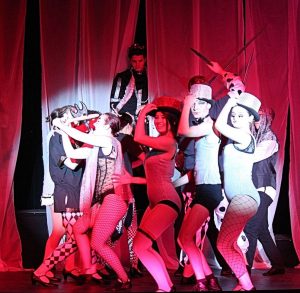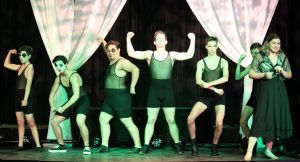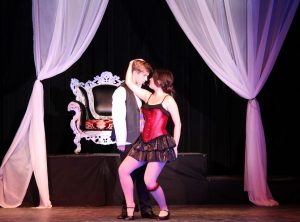Spotlight on resourceful ‘Pippin’ costume designer Lauren Perry
 On stage this weekend for a final four shows is the Alliance Youth Theatre’s production of Pippin.
On stage this weekend for a final four shows is the Alliance Youth Theatre’s production of Pippin.
The 1972 Stephen Schwartz/Roger O. Hirson musical is esteemed for its music and movement, but AYT’s production is also a feast for the eyes because of the unique costumes that are worn by the Players and the other characters who appear in the show’s highly evocative play-within-a-play.
Alliance Youth Theatre’s Lauren Barnhart Perry was responsible for costuming Pippin. It’s a passion she’s been indulging since the age of 14, when she began creating the costumes for the shows her father produced at the middle school in which he taught.
“I just love costumes …  and any excuse for being in costume or creating costumes,” Lauren effused from her perch on the orange couch in the Alliance’s main gallery on Monday evening.
and any excuse for being in costume or creating costumes,” Lauren effused from her perch on the orange couch in the Alliance’s main gallery on Monday evening.
In pursuing her avocation, Perry joins a tradition that traces its origins to the ancient Greek playwright Aeschylus, who created costumes in the 5th century B.C.  for actors to wear when performing his tragedies. In the Middle Ages and the Renaissance, scenery and costumes became increasingly important elements of stage plays. A desire for greater accuracy in costume design began to take hold between 1770 and 1870 due to a dramatic increase in the number of stage performances and because audiences were now more familiar with the clothing
for actors to wear when performing his tragedies. In the Middle Ages and the Renaissance, scenery and costumes became increasingly important elements of stage plays. A desire for greater accuracy in costume design began to take hold between 1770 and 1870 due to a dramatic increase in the number of stage performances and because audiences were now more familiar with the clothing  worn by people from cultures around the globe.
worn by people from cultures around the globe.
Today, costume design embraces two disparate concerns. The first is historical accuracy, or capturing the sense of a time period, such as Les Miserables. The second is concept-driven, in which costumes capture a  vision that may or may not have connections to a known historical time and place like The Wizard of Oz.
vision that may or may not have connections to a known historical time and place like The Wizard of Oz.
The costumes for Pippin actually combine both of these elements. The play is set in late 8th century France, but as the Players are a construct of Pippin’s mind or imagination, the costumes they wear are intended  to convey a particular vision.
to convey a particular vision.
That vision was originally supplied by iconic director and choreographer Bob Fosse. When the show was revived on Broadway in 2013, the mysterious show-within-a-show was reframed as a circus. This re-imagining pleased critics and audiences alike. In fact, the revival won four Tony awards, including the Tony for Best Musical Revival and best direction by Diane Paulus.
On  Broadway and at equity theaters nationwide, the circus-themed play-within-a-play has frequently included acrobatic performances and costumes, as did Broadway Palm Dinner Theatre’s production two seasons ago. However, high-flying aerials and acrobatics is way too ambitious for a show that features high school students whose ages range from 13 to
Broadway and at equity theaters nationwide, the circus-themed play-within-a-play has frequently included acrobatic performances and costumes, as did Broadway Palm Dinner Theatre’s production two seasons ago. However, high-flying aerials and acrobatics is way too ambitious for a show that features high school students whose ages range from 13 to  18 or 19. But the costumes Perry conceived certainly advance the Victorian circus theme of the Broadway revival – without jeopardizing the safety of her entourage of young actors.
18 or 19. But the costumes Perry conceived certainly advance the Victorian circus theme of the Broadway revival – without jeopardizing the safety of her entourage of young actors.
In Perry’s case, budgetary  limitations also presented real-life constraints not encountered on Broadway or in equity theaters. But thanks to Perry’s imaginative approach and extensive wardrobe archive, the costumes in the Alliance Youth Theatre’s Pippin are one of the show’s many strengths.
limitations also presented real-life constraints not encountered on Broadway or in equity theaters. But thanks to Perry’s imaginative approach and extensive wardrobe archive, the costumes in the Alliance Youth Theatre’s Pippin are one of the show’s many strengths.
“Our family has been  in dance our whole lives,” Lauren explained, as the comic book and old movie characters in Ciro Quintana’s large-scale paintings seemingly leaned in to listen closely to Perry’s hushed tones.
in dance our whole lives,” Lauren explained, as the comic book and old movie characters in Ciro Quintana’s large-scale paintings seemingly leaned in to listen closely to Perry’s hushed tones.
Lauren’s mother co-owned a dance studio, exposing her daughter to the art of performing while she was still nestled in the womb. “Mom never threw away a single costume. We have costumes that are 30+ years old. So it was a matter of digging through the bins at my house, in my garage, and in mom’s house and  garage, and then putting them together and picking up assorted items here and there as budget allowed.”
garage, and then putting them together and picking up assorted items here and there as budget allowed.”
While Lauren sews, she doesn’t fabricate the outfits she creates. For her, costume design is a matter of sourcing – whether that entails finding an outfit in her bins that she can recycle or repurpose or finding a piece of clothing or an accessory online, in a thrift store or someplace else that’s  affordable.
affordable.
“This show required a lot of woman hours, and I do more than most because I don’t have the budget other companies have,” she appends matter-of-factly. “I can’t just go ‘I want this. Click. Buy.’ I have to be very judicious in finding things that are affordable;  finding the best deal.”
finding the best deal.”
While costuming any show presents numerous challenges, Pippin is particularly daunting when you consider that the show includes 30 actors and requires multiple costume changes for multiple characters. In addition to the sheer number of costumes required,  the garments have to be durable enough to withstand repeated wear and quick changes between scenes.
the garments have to be durable enough to withstand repeated wear and quick changes between scenes.
To her husband’s chagrin and good-natured perplexity, Perry expended hundreds of [uncompensated] hours to assemble the requisite wardrobe.  But being the consummate professional that she is – and out of love and respect for the youngsters under her charge – she cheerfully devoted the time it took to create the vision that she, Director Carmen Crussard and the rest of their team (Music Director Lindsay Warren, Lighting Designer P.J. McCready and Stage Manager Rachel Jenny) had for the show.
But being the consummate professional that she is – and out of love and respect for the youngsters under her charge – she cheerfully devoted the time it took to create the vision that she, Director Carmen Crussard and the rest of their team (Music Director Lindsay Warren, Lighting Designer P.J. McCready and Stage Manager Rachel Jenny) had for the show.
“It  was like Christmas every day at my house,” she adds with a wide Cheshire Cat grin.
was like Christmas every day at my house,” she adds with a wide Cheshire Cat grin.
The cast’s reaction on costume day made the effort all worthwhile.
“Costume day is super exciting,” Lauren recounted with satisfaction. “The first time they put their costumes on, it takes the show and their performances to a new dimension. It connects them to their characters in a more concrete, less abstract way.”
Of course. We all wear costumes in everyday life. Lawyers, judges, doctors, nurses, carpenters and electricians. When we put on our costume, we assume the role. The same principle applies here.
 As you watch Pippin, there are several aspects that will draw your attention and, ultimately, your appreciations. The first is the vintage and steampunk stylings that Perry incorporated into the Players’ costumes. Next is the incredible detail that Perry incorporates into each costume, right down to the corsets in which she attires the ballerinas in the show. Last but not least is the restrained use of color.
As you watch Pippin, there are several aspects that will draw your attention and, ultimately, your appreciations. The first is the vintage and steampunk stylings that Perry incorporated into the Players’ costumes. Next is the incredible detail that Perry incorporates into each costume, right down to the corsets in which she attires the ballerinas in the show. Last but not least is the restrained use of color.
Throughout the show, the Players are dressed entirely in black and white. The only hints of color appear in the padded cushion in Charlemagne’s throne, a red chair used by Fastrada in one of her  dance numbers, and the pillow on which Charlemagne kneels while he’s praying – and the ruby red gloss worn by the Players on their lips and Giselle Meyer’s beautiful auburn tresses.
dance numbers, and the pillow on which Charlemagne kneels while he’s praying – and the ruby red gloss worn by the Players on their lips and Giselle Meyer’s beautiful auburn tresses.
The motif is intentional. Black and white reflects the theme of dreaming.  (Most people dream only in monotone.) It is also a color scheme that has been employed in circus shows during Victorian times.
(Most people dream only in monotone.) It is also a color scheme that has been employed in circus shows during Victorian times.
But in Pippin, this stark monochrome color scheme is interrupted by flashes of red.
“Carmen had the idea that only Leading Player would ever wear red,  and that the amount of red she wears in her outfits or accessories would increase as the show progresses until the final scene, in which she’s predominantly clad in red and everybody has a piece of red in their outfit to compliment hers,” Lauren divulges.
and that the amount of red she wears in her outfits or accessories would increase as the show progresses until the final scene, in which she’s predominantly clad in red and everybody has a piece of red in their outfit to compliment hers,” Lauren divulges.
It fell upon  Lauren to come up with the accessories that would implement Carmen’s costume plot for the Leading Player (brilliantly brought to life by Yuliana Garcia). It starts with a red garter, and goes on to include top hats, leather gloves, Venetian masquerade mask , slim silver-buttoned corset and, finally, padded red top coat and glittery red Victorian Steampunk top hat.
Lauren to come up with the accessories that would implement Carmen’s costume plot for the Leading Player (brilliantly brought to life by Yuliana Garcia). It starts with a red garter, and goes on to include top hats, leather gloves, Venetian masquerade mask , slim silver-buttoned corset and, finally, padded red top coat and glittery red Victorian Steampunk top hat.
 The singular dash of color leading up to the finale creates stunning contrast and adds to the sense of passion that the Leading Player conjures in each of her scenes.
The singular dash of color leading up to the finale creates stunning contrast and adds to the sense of passion that the Leading Player conjures in each of her scenes.
And while passion underlies the costuming on display in Pippin, it is also a tribute to Perry’s resourcefulness, imagination and deep knowledge and appreciation of clothing and fashion across the board.
 It’s fun to imagine what Lauren could do if she had a larger budget to work with (hint, hint, benefactors) and what she will do in upcoming shows like Children of Eden, Jr., Rent and Charlotte’s Web.
It’s fun to imagine what Lauren could do if she had a larger budget to work with (hint, hint, benefactors) and what she will do in upcoming shows like Children of Eden, Jr., Rent and Charlotte’s Web.
Remaining performances of Pippin are at 7:30 p.m. on Friday and Saturday and at 2:00 p.m. on Saturday and Sunday afternoon.
November 20, 2019.














 Tom Hall is both an amateur artist and aspiring novelist who writes art quest thrillers. He is in the final stages of completing his debut novel titled "Art Detective," a story that fictionalizes the discovery of the fabled billion-dollar Impressionist collection of Parisian art dealer Josse Bernheim-Jeune, thought by many to have perished during World War II when the collection's hiding place, Castle de Rastignac in southern France, was destroyed by the Wehrmacht in reprisal for attacks made by members of the Resistance operating in the area. A former tax attorney, Tom holds a bachelor's degree as well as both a juris doctorate and masters of laws in taxation from the University of Florida. Tom lives in Estero, Florida with his fiancee, Connie, and their four cats.
Tom Hall is both an amateur artist and aspiring novelist who writes art quest thrillers. He is in the final stages of completing his debut novel titled "Art Detective," a story that fictionalizes the discovery of the fabled billion-dollar Impressionist collection of Parisian art dealer Josse Bernheim-Jeune, thought by many to have perished during World War II when the collection's hiding place, Castle de Rastignac in southern France, was destroyed by the Wehrmacht in reprisal for attacks made by members of the Resistance operating in the area. A former tax attorney, Tom holds a bachelor's degree as well as both a juris doctorate and masters of laws in taxation from the University of Florida. Tom lives in Estero, Florida with his fiancee, Connie, and their four cats.